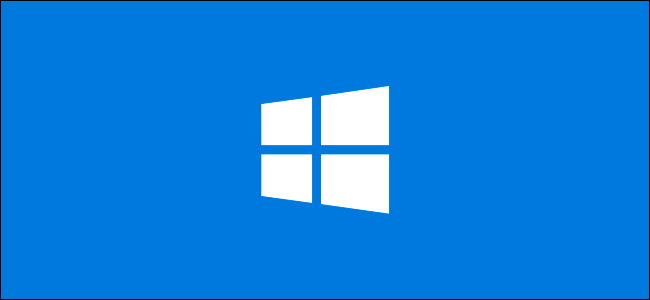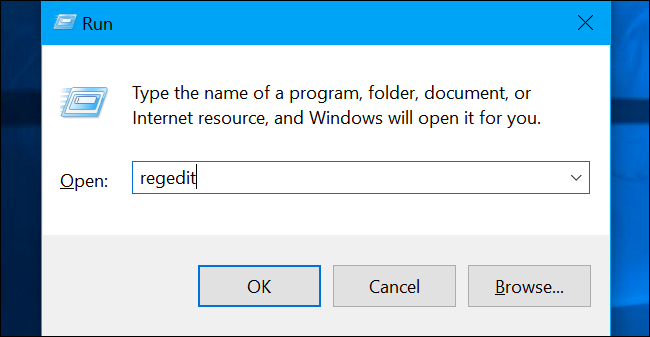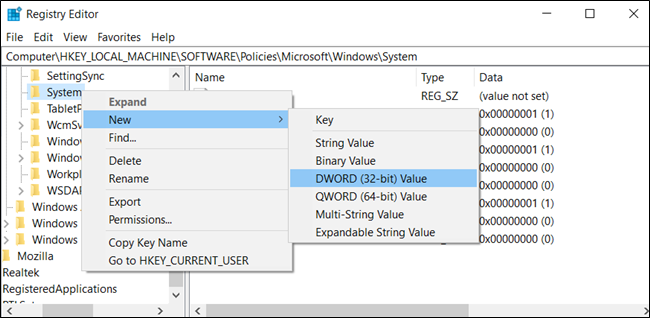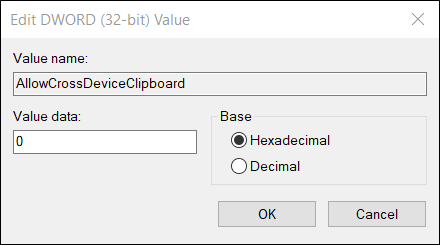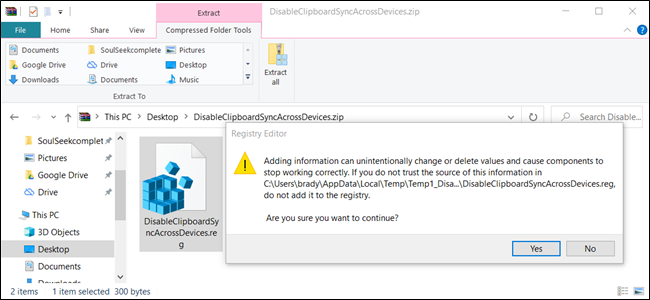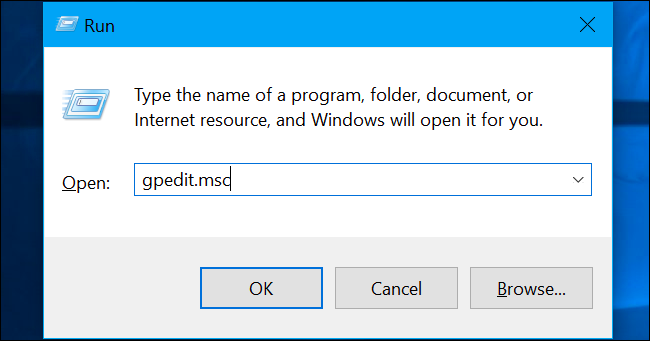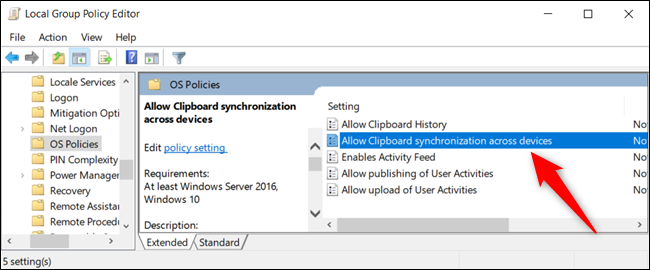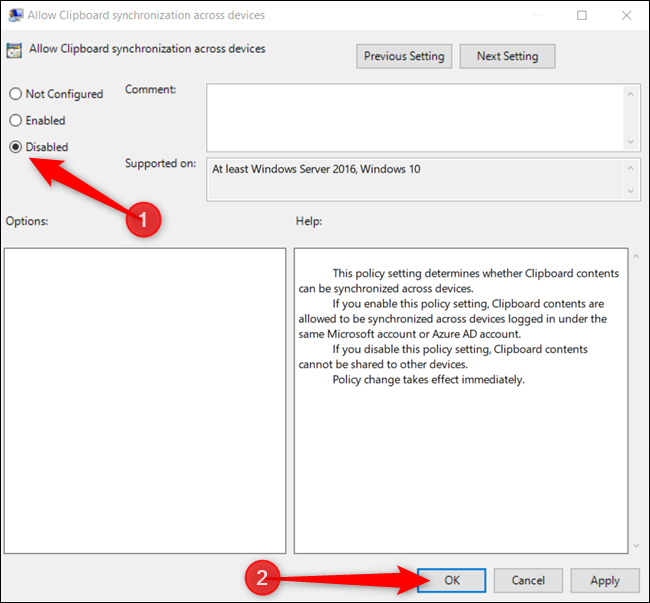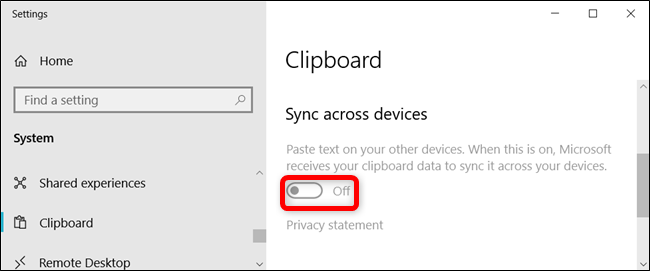Quick Links
Windows 10's Clipboard experience lets you access a history of items you've copied, pin frequently used items, and sync items across all devices. However, if you don't want Microsoft to sync any sensitive data to the cloud, you can disable it completely.
By default, Clipboard sync is turned off. If it's already on, you can toggle clipboard features in Settings > System > Clipboard. But when you enable the sync feature, it automatically syncs all text that you copy.
To prevent any user on the computer from enabling this and accidentally syncing potentially sensitive data such as passwords to Microsoft's servers, you can disable this feature altogether.
Home Users: Disable Clipboard Sync via the Registry Editor
If you have Windows 10 Home, you’ll have to edit the Windows Registry to make these changes. You can also do it this way if you have Windows 10 Professional or Enterprise if you feel more comfortable working in the Registry as opposed to Group Policy Editor. (If you have Pro or Enterprise, though, we recommend using the easier Group Policy Editor, as described in the next section.)
Standard warning: Registry Editor is a powerful tool and misusing it can render your system unstable or even inoperable. This is a pretty simple hack, and as long as you stick to the instructions, you shouldn’t have any problems. That said, if you’ve never worked with it before, consider reading about how to use the Registry Editor before you get started. And definitely back up the Registry (and your computer!) before making changes.
You should also make a System Restore point before continuing. Windows will probably do this automatically when you install the Anniversary Update, but it couldn’t hurt to make one manually---that way, if something goes wrong, you can always roll back.
Then, open the Registry Editor by pressing Windows+R on your keyboard, typing “regedit” into the box, and then hitting the Enter key.
Navigate to the following key in the left sidebar:
HKEY_LOCAL_MACHINE\SOFTWARE\Policies\Microsoft\Windows\System
Once here, right-click on the "System" key (folder) in the left pane and select New > DWORD (32-bit) Value.
Name the value "AllowCrossDeviceClipboard." Double-click it and set the value to "0."
You can now close the registry editor. You don't have to sign out or restart your computer for the changes to take effect.
To re-enable cross-device synchronization for Clipboard, you can return here, locate the "AllowCrossDeviceClipboard" value, and set it back to "1" or delete it completely.
Download Our One-Click Registry Hack
Rather than editing the registry yourself, you can download our Disable Clipboard Sync across Devices Registry Hack. Just open the downloaded .zip file, double-click the “DisableClipboardSyncAcrossDevices.reg" file, and agree to add the information to your registry. We've also included an "EnableClipboardSyncAcrossDevices.reg" if you'd like to re-enable it again.
These .reg files change the same registry settings we outlined above. If you’d like to see what this or any other .reg file will do before you run it, you can right-click the .reg file and select “Edit” to open it in Notepad. You can easily make your own Registry hacks.
Pro and Enterprise Users: Disable Clipboard Sync via Group Policy
If you’re using Windows 10 Professional or Enterprise, the easiest way to disable Clipboard sync across devices is by using the Local Group Policy Editor. It’s a pretty powerful tool, so if you’ve never used it before, it’s worth taking some time to learn what it can do.
Also, if you’re on a company network, do everyone a favor and check with your admin first. If your work computer is part of a domain, it’s also likely it’s part of a domain group policy that will supersede the local group policy, anyway.
You should also make a System Restore point before continuing. Windows will probably do this automatically when you install the Anniversary Update. Still, it couldn’t hurt to make one manually---that way, if something goes wrong, you can always roll back.
First, launch the group policy editor by pressing Windows+R, typing “gpedit.msc” into the box, and then pressing the Enter key.
Navigate to Computer Configuration > Administrative Templates > System > OS Policies.
Locate the "Allow Clipboard Synchronization across Devices" setting and double-click on it.
Set the "Allow Synchronization across Devices" option to "Disabled" and then click the "OK" button to save your changes.
The policy change takes effect immediately. You can now close the Group Policy Editor without needing to restart your device before the setting is disabled.
To re-enable Clipboard synchronization across devices, return here, double-click the "Allow Clipboard Synchronization across Devices" setting, and then change it to "Not Configured" or "Enabled."

